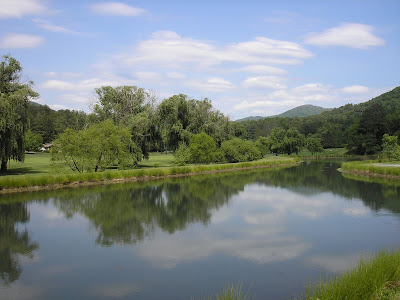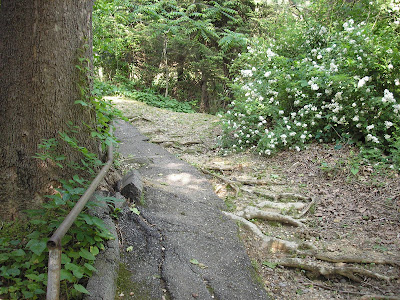View Larger Map
Religious differences
They worship differently in north Asheville from west Asheville. In west Asheville, I noticed, though there was one Yoga center and a sprinkling of New Age herbal healing schools, most churches were either Baptist or Methodist.
In north Asheville, I saw no Baptist churches, only Episcopal and Presbyterian, but I know that are also two Jewish synagogues, a Friends meeting house, several Yoga centers, and one Zen Center.
This led me to the telephone book where I counted Asheville’s advertised religious communities: I counted nearly 350, and while some may have been counted more than once, I checked and found very little duplication in the list of churches in the Yellow Pages. (For instance, I did not count churches listed under Orthodox that I'd already counted under Greek or Eastern Orthodox.)
Among the 350 communities more than 100 were Baptist of one sort or another. Seventy-five called themselves Baptist, and another 54 called themselves “southern,” “general,” “free-will,” “independent,” “missionary,” or “grace missionary.”
The next most common faiths were Methodist (35), Presbyterian (25), Nondenominational (17), Episcopalian and Anglican (15), Roman Catholic (10). I counted 62 different faiths – some with only one Asheville congregation, others with several – and they represented a broad range: African Methodist Episcopal, Baha’i, Buddhist, Church of God, Full Gospel, Holiness, Lutheran, Mormon, Muslim, Pentecostal, Salvation Army, Seventh Day Adventist (and Baptist), Unitarian, Zen. I did not see advertised but know there is at least one Hindu community here. I also know of half dozen Buddhist communities that were not listed in the telephone book (at least not in the places I was looking).
I do not know street names well enough to place them all, but I am confident that just as there are class differences between west and north Asheville, there also are religious differences. Of course, a systematic study would include not just houses of worship but also worshippers – one neighborhood may have more churches but fewer worshippers than another. Still I think the walk through the phone book was suggestive.
Bus ridership
Another difference that was immediately apparent was that, while the west Asheville bus was nearly full, the north Asheville bus was all-but-empty: there was one woman at the back when I boarded. Another man got on when the bus reached Merrimon Avenue. Both got off at Ingles at Beaver Dam Road. I was the lone passenger from there to the city’s edge at Elkmont.
So two glaring differences: churches and bus ridership. Doubtless there are others.
I got off the bus in a commercial area with lots of shady trees. It’s a transition area between the Beaver Lake community to the south and the strip of gas stations, alignment shops, groceries, lumber yards, cheese and wine stores, and restaurants that crowd Merrimon for the next couple of miles north.
Beaver Lake

 Turning south back into the city, I came first upon the affluent Beaver Lake community. If west Asheville’s neighborhoods felt rural, in a family-farm sort of way, this part of north Asheville pretended to gentry. The homes here were not mansions, but they were large and over determined, with leaded windows and carved doors and wide, freshly painted porches with stone floors, and steep lawns falling to street or the lake itself. On one porch I saw a large, life-sized statue of a sitting Buddha.
Turning south back into the city, I came first upon the affluent Beaver Lake community. If west Asheville’s neighborhoods felt rural, in a family-farm sort of way, this part of north Asheville pretended to gentry. The homes here were not mansions, but they were large and over determined, with leaded windows and carved doors and wide, freshly painted porches with stone floors, and steep lawns falling to street or the lake itself. On one porch I saw a large, life-sized statue of a sitting Buddha.
 The fact that this community has a private lake and two golf courses says something of its privilege, in contrast to west Asheville, which has its charms but neither lake nor golf course).
The fact that this community has a private lake and two golf courses says something of its privilege, in contrast to west Asheville, which has its charms but neither lake nor golf course).

I continued south on Merrimon, past Beaver Lake on my right and the Country Club of Asheville on my left. The street is lined with large sycamores. There were geese and ducks on the lake. A hawk sailed overhead. I saw a red-winged blackbird, which I have not seen around here. A mother and children walked their lion-sized golden retriever on the golf course. This was a picture for the cover of affluent America: not rich, but upper middle class. The cars here: new Volvos, BMWs, Audis, and Mercedes Benzes.

The road fell to a creek that flowed from the golf course, under the pavement, and into a bird sanctuary (yes, Beaver Lake has a large bird park on the south end of the lake) where the creek met another coming from farther south and together fed Beaver Lake. I saw a couple of male blue gills defending nests in the creek’s shallow waters.
 After the sanctuary came the new North Asheville Public Library, and then a series of strip shopping centers, including an Ingles, a Fresh Market, several travel agencies, a number of restaurants (from Marco’s Pizza to the upscale Savoy), several convenience and gas stations, at least six drug stores (in a span of under two miles), all but one built within the past six years, a family-owned toy store, several banks, real estate offices, a UPC store, insurance agencies, an ABC liquor store, a financial consulting firm. In this section, billboards advertised BB Barns Nursery (for landscaping needs), the upcoming Ringling Bros. Circus, U.S. Cellular phones, and Carlyle & Co. jewelers.
After the sanctuary came the new North Asheville Public Library, and then a series of strip shopping centers, including an Ingles, a Fresh Market, several travel agencies, a number of restaurants (from Marco’s Pizza to the upscale Savoy), several convenience and gas stations, at least six drug stores (in a span of under two miles), all but one built within the past six years, a family-owned toy store, several banks, real estate offices, a UPC store, insurance agencies, an ABC liquor store, a financial consulting firm. In this section, billboards advertised BB Barns Nursery (for landscaping needs), the upcoming Ringling Bros. Circus, U.S. Cellular phones, and Carlyle & Co. jewelers.A small neighborhood

 At the top of the hill, where a trendy bar called The Usual Suspects sits, I turned left on Gracelyn Road, past Grace Covenant Presbyterian Church. A colleague who lives back in this neighborhood had asked me to stop by to help move a new dryer into his basement. I turned right on Melrose, and then made the first left onto my colleague’s street. We moved the dryer in a few minutes, he gave me a glass of cold water, and we spent a few minutes talking about the neighborhood. I counted three renovation projects in two small blocks. He said that neighbors were putting a lot of work into their houses (as was he), not to sell but for themselves to live in. As we stood talking, a woman in one of these houses approached with a baby in her arms: a family-friendly community. She called my colleague by his first name.
At the top of the hill, where a trendy bar called The Usual Suspects sits, I turned left on Gracelyn Road, past Grace Covenant Presbyterian Church. A colleague who lives back in this neighborhood had asked me to stop by to help move a new dryer into his basement. I turned right on Melrose, and then made the first left onto my colleague’s street. We moved the dryer in a few minutes, he gave me a glass of cold water, and we spent a few minutes talking about the neighborhood. I counted three renovation projects in two small blocks. He said that neighbors were putting a lot of work into their houses (as was he), not to sell but for themselves to live in. As we stood talking, a woman in one of these houses approached with a baby in her arms: a family-friendly community. She called my colleague by his first name.I returned to Melrose, turned left, and at my colleague’s direction, found a path at the end of the street that curved down through a small wood to Long Street, which parallel’s Merrimon and provides back access to a number of business along Merrimon.

More businesses

 I walked through the parking lots for a honeyed ham store and burger parlor, turned left on Merrimon and continued my journey south. At Edgewood I turned right toward UNC Asheville, passed through a different sort of neighborhood, pleasant but not as affluent as Beaver Lake or up and coming as the Melrose area. This is no doubt the result of several apartment complexes along Edgewood and the number of transient students in the area. I know from other walks that neighborhoods to the north and south of Edgewood are more stable and, especially those just to the north of it, the houses are finer and larger and perhaps more owner-occupied.
I walked through the parking lots for a honeyed ham store and burger parlor, turned left on Merrimon and continued my journey south. At Edgewood I turned right toward UNC Asheville, passed through a different sort of neighborhood, pleasant but not as affluent as Beaver Lake or up and coming as the Melrose area. This is no doubt the result of several apartment complexes along Edgewood and the number of transient students in the area. I know from other walks that neighborhoods to the north and south of Edgewood are more stable and, especially those just to the north of it, the houses are finer and larger and perhaps more owner-occupied.
An ecological observation: we are enjoying the emergence of the 17 year cicadas now, but their appearance is uneven. They are all over much of campus (at least my corner of it). They are crawling on trees. Their cast off exoskeletons litter the sidewalks. You can hear them whir like spaceships and buzz saws in tree tops. But not everywhere. I heard none along Beaver Lake. I heard them in the Melrose area. I heard them on campus. I do not hear them in my own neighborhood.
That would be an interesting map: where the cicada sing and where they don’t.

No comments:
Post a Comment